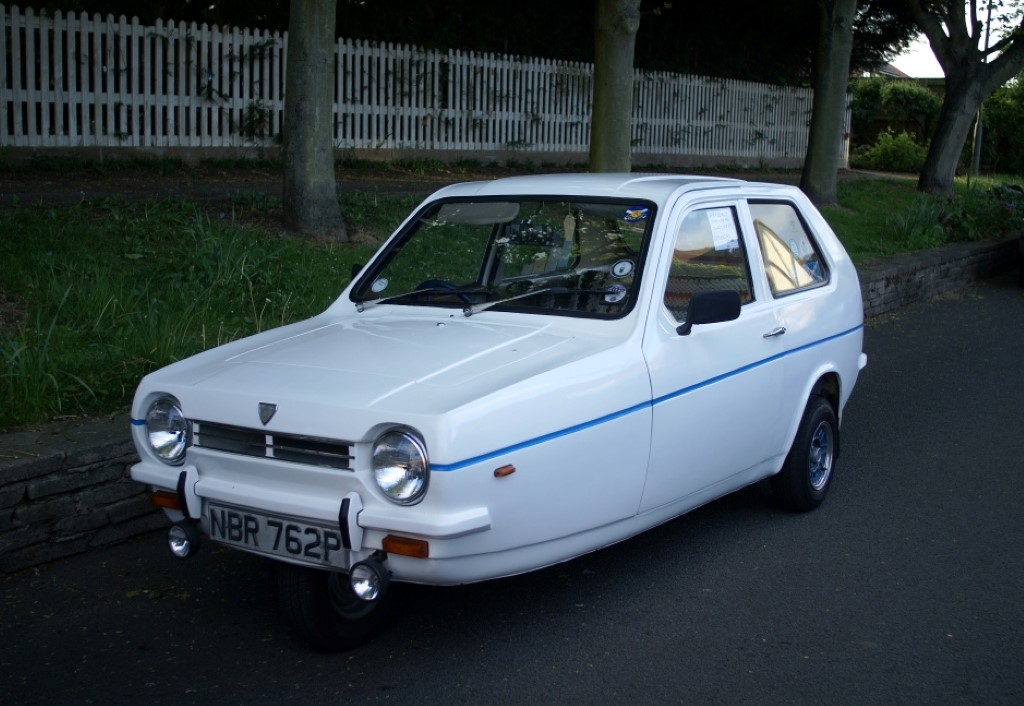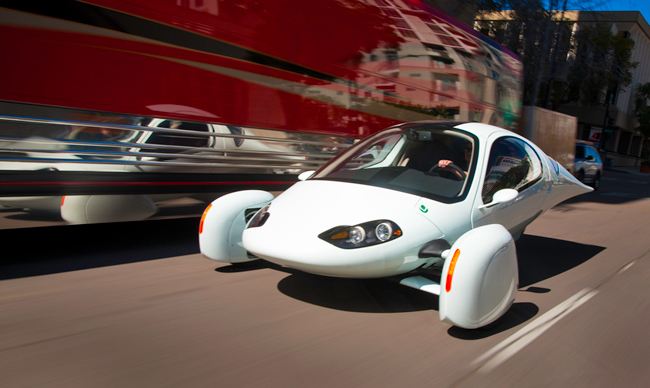What do the Elio, Aptera, Toyota i-Road concept and the spectacularly awful Zap Xebra have in common?
They--and many more small-volume economical vehicles and concepts besides--all use one fewer wheel than the norm.
Yet giving fuel-saving cars just three wheels is not a new phenomenon, stretching right back to the dawn of the motor car--with periodic resurgences in popularity when the market demands it.
READ: What It Takes To Build A Tesla Supercharger DC Fast-Charging Site
Depending on what history book you read, the world's very first true motorcar, the 1886 Benz Patent Motorwagen, rolled along on just three wheels.
It had been preceded by several similar vehicles, often steam-powered, whose layouts were dictated by the simplicity of tiller steering for the single front wheel.
And, with less than one horsepower, and very tall, widely-spaced wheels, Karl Benz's customers never really had to worry about the lack of stability that would characterize a similar layout decades later.
In 1910, one of the world's most famous three-wheel car producers was formed: Morgan. Still around today, the Morgan sports car company turned to three wheels for the simple construction and weight benefits they presented.
These are still beneficial to the company today with the latest iteration of the 3-Wheeler sports car. Narrow tires and a low center of gravity ensure grip runs out before lateral forces become a problem, but the fun factor of such a light car powered by a hefty V-twin engine and rear-wheel drive can't be understated.

Morgan 3 Wheeler
Several other manufacturers introduced three-wheel vehicles between the early 1900s and the middle of the century, but it was the after-effects of World War II that changed the market completely.
Many European countries, crippled both physically and financially following the war, saw demand for cheap transportation that could carry whole families. Materials were in short supply, but the traditional motorcycle and sidecar option was neither safe nor practical enough.
MUST SEE: Tesla Model S: The Electric Car For 'Mistresses', Apparently
Step forward the microcar: companies like BMW, Messerschmitt, Bond, Reliant and others all took advantage of tax restrictions and new laws by fielding inexpensive but characterful three-wheelers for the next decade or so.
Here were cars that were economical to both buy and run--where light weight, tiny and thrifty engines and dinky size meant that regular families and individuals could afford an actual car. Design was dictated by purpose, but these cars are now appreciated by collectors for their design as much as their motive.
Europe's market could hardly be in greater contrast to that of the U.S, where a more hopeful and financially flush market turned out some of the most spectacular (and profligate) cars the country has ever produced.

Reliant Robin (Image by Flickr user Yaffa Phillips, used under CC License 2.0)
The original Mini and Fiat 500 killed demand for three-wheeled cars in Europe--all of a sudden, here were cars that offered all the benefits of previous microcars for little more money, but a great deal more practicality.
In the 1970s, the fuel crisis changed things again. While American firms reacted by rapidly downsizing engines and strangling the ubiquitous V-8s with fuel injection and emission controls, UK three-wheeler specialist Reliant responded with the Robin. Capable of as much as 60 mpg in normal driving, seating four in its 131-inch frame and weighing in at under 1,100 lbs, its timing was perfect.
ALSO SEE: 2014 BMW i3 REx Vs. Chevy volt: Range-Extended Electric Cars Compared
America did, briefly, have an equivalent to the Robin. The 'Dale' scandal has gone down in automotive industry folklore, but its statistics were remarkably close to that of the Robin.
Conceptualized by the Twentieth Century Motor Car Corporation, the Dale three-wheeler would weigh under 1,000 lbs, achieve 70 mpg and hit 85 mph. The Robin's own statistics suggest that had it come to fruition, it might well have hit all those targets--but it rapidly transpired that founder Geraldine Elizabeth Carmichael had no plans to put the car into production and instead went into hiding, taking investors' money with her. She was later arrested and sent to prison for fraud.
Back in the UK, Robin production continued in one form or another right into the early 2000s, aided by the car's low price, cheap insurance and the fact that drivers who'd earned their driving permit by a certain age could drive one on a motorcycle license alone.

1975 Dale three-wheeled car
But by the time of its eventual death--after a final, curvy 1990s-style visual update--the product was far outclassed in most areas by more conventional cars. Even so, few could match its economy, particularly for the money.
One that got close was Smart. The only true high-volume microcar of the late 20th and early 21st centuries, the Daimler city car brand has proved that the market for microcars is still there--in Europe, at least--but consumers now prefer their vehicles to have four wheels.
CHECK OUT: Saleen FourSixteen Is Modified Tesla Model S: Full Details
Produced since 1998, Smart has now sold over 1.5 million Fortwo models, and while the company still struggles to make a profit, its high-tech approach is illustrative of the level that auto manufacturers now operate at--and why tiny firms like Reliant faded away just as their counterparts did in the 1960s.
All the while though, kit car manufacturers and those building cars for economy alone have persisted with three wheels. If you're building a vehicle in your garage (or designing a car for others to do so), three wheels is still one of the simplest and cheapest ways to engineer it.
It's unsurprising that two of the last decade's highest-profile green cars have gone down the three-wheel route.

Aptera 2e
Aptera chose such a layout for its 2e in 2006. Here, the benefit was aerodynamics and low weight--the car's tadpole-like form could seat two passengers, with two outboard front wheels and a single rear wheel dictated by its shape.
Its smooth lines promised an ultra-low drag coefficient and certainly gave it a futuristic shape, while options for electric power or a hybrid drivetrain ensured it would cover the needs of customers.
Unfortunately, it was not to be. For Aptera to be eligible for loans from the U.S. Department of Energy--like those taken by Tesla and Fisker--it needed four wheels.
ALSO READ: Aptera Collapse: How & Why It Happened, A Complete Chronology
While Aptera hastily drew up plans for a conventional four-seat sedan, the company failed to raise the private capital it needed to justify a DoE loan, and closed its doors in December 2011.
Perhaps Elio will be more successful. Its car is a simpler concept, with a small gasoline engine, front wheel drive and a distinctive yet conceptually unremarkable shape.
It seats two, in tandem, and comes with some impressive claims--84 mpg highway and a $6,800 price tag. The firm has a factory, thousands of potentially interested customers and its vehicle has made far more public appearances than Aptera ever did.
![Elio Motors 84 mpg 3-wheeler [Image: Elio Motors] Elio Motors 84 mpg 3-wheeler [Image: Elio Motors]](https://images.hgmsites.net/lrg/elio-motors-84-mpg-3-wheeler-image-elio-motors_100477636_l.jpg)
Elio Motors 84 mpg 3-wheeler [Image: Elio Motors]
As a three-wheeler, it also has a legislative advantage over conventional four-wheeled vehicles. Three-wheelers don't have to meet the same strict safety standards, for example.
Sure, Aptera and Elio have both claimed big-car safety features from their vehicles--airbags, ABS and the like--but opting for one fewer wheel means much greater freedom in creating a car. Despite the apparent compromise of having just three wheels next to four, the cars can actually be less compromised for the twin benefits of affordability and economy.
We're yet to see how well Elio will do, even in an increasingly economy-focused market. The firm hasn't yet began production and few have got to drive its 84 mpg highway-capable 3-wheeler.
But if it succeeds, perhaps we'll see a resurgence in the sort of fuel-efficient three-wheel cars that thrived in the economic period following the Second World War.
If it doesn't, at least Morgan has proven there's still a market for a three-wheeled vehicle if you're marketing to affluent, thrill-seeking buyers...
_________________________________________













